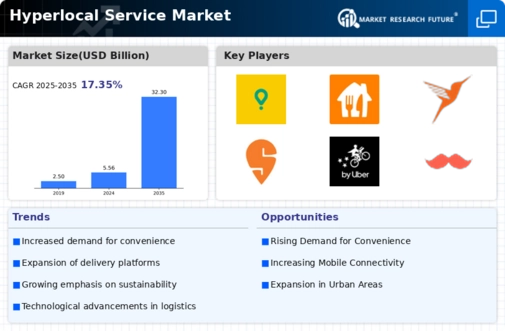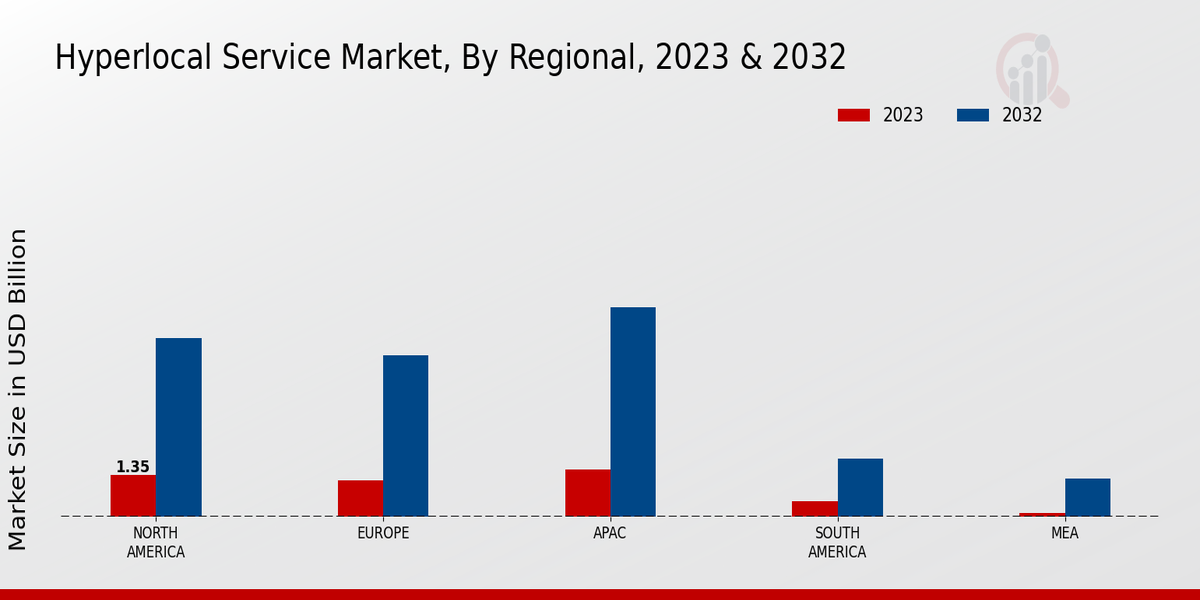Rising Urbanization
The Global Hyperlocal Service Market Industry is experiencing a notable surge due to increasing urbanization. As more individuals migrate to urban areas, the demand for localized services such as food delivery, home cleaning, and personal care rises. In 2024, the market is projected to reach 5.56 USD Billion, reflecting the growing need for convenience in densely populated regions. Urban dwellers often seek quick and efficient solutions for their daily needs, which hyperlocal services adeptly provide. This trend is expected to continue, as urban populations are anticipated to increase, further driving the growth of the hyperlocal service sector.
Market Growth Projections
The Global Hyperlocal Service Market Industry is poised for substantial growth, with projections indicating a market size of 5.56 USD Billion in 2024 and a remarkable increase to 32.3 USD Billion by 2035. This growth trajectory suggests a compound annual growth rate of 17.35% from 2025 to 2035. Such figures reflect the increasing demand for localized services across various sectors, including food delivery, home services, and personal care. The market's expansion is likely to be driven by factors such as urbanization, technological advancements, and changing consumer preferences, all contributing to a robust and dynamic hyperlocal service landscape.
Technological Advancements
Technological innovations play a pivotal role in shaping the Global Hyperlocal Service Market Industry. The proliferation of smartphones and mobile applications facilitates seamless access to hyperlocal services, enhancing user experience. For instance, platforms that utilize geolocation technology can efficiently connect service providers with consumers in real-time. These advancements not only streamline operations but also improve service delivery speed. As the market evolves, it is likely that further technological enhancements will emerge, potentially increasing the market size to 32.3 USD Billion by 2035. This growth underscores the importance of technology in driving consumer engagement and satisfaction within the hyperlocal service landscape.
Changing Consumer Preferences
The Global Hyperlocal Service Market Industry is significantly influenced by shifting consumer preferences towards convenience and immediacy. Modern consumers increasingly prioritize services that save time and effort, leading to a surge in demand for hyperlocal offerings. For example, the rise of on-demand delivery services illustrates this trend, as consumers opt for quick solutions for their daily needs. This shift is expected to contribute to a compound annual growth rate of 17.35% from 2025 to 2035, indicating a robust future for hyperlocal services. As consumer expectations evolve, businesses must adapt to meet these demands, further propelling market growth.
Increased Investment in Startups
The Global Hyperlocal Service Market Industry is witnessing a surge in investment directed towards startups specializing in localized services. Venture capitalists and angel investors are increasingly recognizing the potential of hyperlocal businesses, leading to a wave of funding that fuels innovation and expansion. This influx of capital enables startups to enhance their service offerings and improve operational efficiencies. As a result, the market is likely to experience accelerated growth, with projections indicating a rise to 32.3 USD Billion by 2035. This trend highlights the dynamic nature of the hyperlocal service sector, where investment plays a crucial role in shaping future developments.
Environmental Sustainability Trends
The Global Hyperlocal Service Market Industry is increasingly aligning with environmental sustainability trends, as consumers become more conscious of their ecological footprint. Many hyperlocal service providers are adopting eco-friendly practices, such as using sustainable packaging and promoting local sourcing. This shift not only appeals to environmentally aware consumers but also enhances brand loyalty and trust. As sustainability becomes a core value for many businesses, the hyperlocal service market is likely to benefit from this trend, potentially reaching a market size of 32.3 USD Billion by 2035. The integration of sustainability into service offerings may also attract a broader customer base, further driving growth.

























